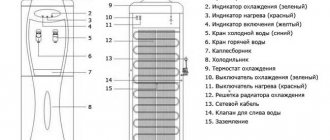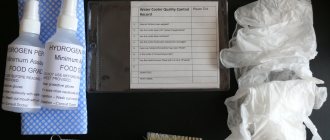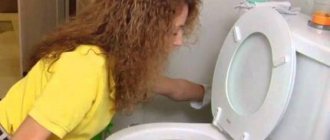It makes sense to contact a service center or call a specialist in the rarest cases. For example, in winter, in unheated rooms, a hot water tank sometimes bursts. The cooler can crack from the inside when it is moved without draining the water from the barrels; in such cases, the internal tubes are often damaged. There is a high chance of damage to some faucet when a large number of people use the cooler.
Poor quality packaging is one of the most common reasons why a water cooler leaks.
For some people, the cooler can work properly for many years, while others constantly face the problem of leakage. The reason lies in how correctly the dispenser was used. And this is sometimes very difficult to control. After all, the device can be used by several family members or a large team of office employees.
Although it also happens that a cooler can leak, even if it has one very thrifty owner. Therefore, before the puddle that forms under the dispenser ruins your mood and entails unplanned expenses, you should figure out what problems can be prevented by everyone who bought this useful device.
There is a possibility that the dispenser itself does not need repair. It happens that the integrity of the bottle itself, which contains purified water for the cooler, is broken.
Frequent breakdowns of water coolers and how to fix them
The dispenser begins to leak during operation and a puddle forms. In 99 cases out of 100, the cause of such a water cooler malfunction is a defective bottle that has a microcrack that allows air to enter the system. As a result, the liquid overflows the device’s storage tanks and spills onto the floor. To eliminate this problem, simply change the bottle and drain excess water - a liter from each tap. If this does not help, you should contact the service center.
The water from the cooler taps began to flow poorly.
Most likely, the device needs washing and sanitation. And in this case, you should entrust your water cooler to specialists; it is better to diagnose faults and fix them in a service center.
Water leaks from hot or cold taps.
Taps with mug pressure have one defect due to their design. The upper part of the faucet can unwind, and this becomes the cause of such malfunction. To solve the problem, you need to tighten the top tightening of the faucet. But it may also happen that during operation, the plastic elements of the faucets begin to crack from hot water and a leak forms. This is not a warranty issue and replacement of the taps is the responsibility of the cooler owner.
The cooler does not heat the water.
The reason that the cooler has stopped heating water may be a failure of the temperature sensor or a blown fuse. In addition, damage to the heating element or the heating tank itself may occur. Regardless of the cause of the malfunction of the water cooler, it will not be possible to fix such a breakdown without the help of a technician.
The cooler does not cool the water.
The most common problems: the Peltier element has failed (for a cooler with electronic cooling), a refrigerant leak has occurred, or the compressor has stopped working (for compressor devices). Whatever the reason that led to the malfunction of the water cooler, the device can only be repaired by a service center.
Any equipment has its own resource. When it is produced, a series of various malfunctions in the operation of the device begins to occur. The cooler may begin to leak, underheat or cool the water poorly, and the control panel and faucets may break down. When the device is severely worn out, water cooler malfunctions appear that cannot be repaired.
Recommended articles on this topic:
- Types of water coolers: models, functions, photos
- Water cooler for the office: types and selection criteria
- How to drink water correctly: nuances and tips
Hot water tap does not flow
If you open a hot tap and the water barely drips or does not flow at all, you need to replace the bottle. But if cold water flows from a hot tap, then in this case you need to:
- Wait 15-20 minutes until the heat exchanger radiator heats up and try to get hot water again.
- Check the power supply - the dispenser may have been disconnected from the network, and without electricity it only dispenses cold water.
- Turn on the fuse - when overheating, the cooler is disconnected from the network, de-energizing the heating circuit.
What to do if there is a full bottle on the cooler and it is plugged in? Of course, contact the specialists from the service center. In this case, repairing coolers yourself is impossible. The technician will have to disassemble the device, remove the broken or clogged heat exchanger, wash it and put it back in place. Along the way, he will check the wiring and change the fuses. This work cannot be done without a special tool.
Even the most experienced craftsman will not be able to make a dispenser at home. Therefore, do not waste money on calling specialists - immediately take the cooler to the service center.
The cause of the leak may be in the faucet.
So, if it turns out that the container is in order, then the next culprit of the leak may be the tap. But even if it is faulty, this is not a reason to immediately call the service center. It is quite possible to adjust, repair and even replace the faucet yourself. It happens that a piece of protective film from the bottle gets into the tap and turns it off. You can solve the problem by unscrewing the top cover, removing a piece of film and tightly screwing the faucet cap. Before manipulating the faucet, it is best to read the instructions for this cooler.
However, the faucet may leak due to serious damage if the device is in a cold room. In winter, temperature changes can cause the hot water tank to crack.
Often the hot water faucet begins to drip due to the fact that limescale has accumulated inside it. You need to remove the cap and clean the valve with your hands, scraping off the plaque.
Internal damage to the faucet or supply pipes may occur due to rough movement of the device from place to place.
If a large number of people use the dispenser, then one of these careless users may simply break the tap.
How to replace a cooler tap with your own hands
Most modern water dispensers have spare parts that are readily available from the manufacturers. And to install many of these basic parts, incl. and taps, do not even require tools other than a regular screwdriver or wrench. If you don’t intuitively understand how to replace an old faucet, read about it in the instructions for the device.
As a last resort, if you do not have the original spare valve, you can temporarily use regular water ball valves. They are simply screwed onto threaded fittings, with waterproofing tape.
Very often, customers contact us about water leaks.
The working cooler suddenly begins to leak inside, and a puddle of water forms under it. In 99% of cases, the reason is a defective bottle - it has a microcrack through which air is sucked into the system - the cooler tanks overflow and begin to leak over the edge. This is a defect of the bottle, not the cooler. You just need to replace the bottle with another one, drain 1 liter of water from each tap and the problem is solved. To do this, you don’t need to take the cooler to a service center or call a specialist - everything can be solved by simply replacing the bottle.
Leaks from under the lid at the top
Such a malfunction will most likely require contacting a service center or calling a specialist. If this is a new cooler, then a possible reason is that there is no special button in the water drain valve.
If a leak occurs over time, then this is a serious signal about the need for a thorough repair or replacement of the bottle receiver. But the reason may be more prosaic - in the leaky cap of the bottle itself, this is written in paragraphs 5 and 6 of the above instructions on the procedure for primary diagnosis.
General provisions
| Designation in the figure | Name |
| 1 | Bottle installation location |
| 2 | Green cooling indicator |
| 3 | Red heating indicator |
| 4 | Yellow power indicator |
| 5 | Cold water tap |
| 6 | Hot water tap |
| 7 | Collection container for drops |
| 8 | Cooling system |
| 9 | Cooling thermostat |
| 10 | Green cooling switch |
| 11 | Red heating switch |
| 12 | Cooling radiator |
| 13 | Network connection wire |
| 14 | Drain valve |
| 15 | Grounding |
As you can see from the given structure of the water dispenser, the faucets are indeed precisely the part with which a person who decides to drink from the cooler comes into contact. Consequently, the requirements for it must be special.
When should I take my cooler in for repair?
As you can see, you can do without the help of specialists only in rare cases, since quite often the cooler leaks due to a more serious breakdown:
- in an unheated room (especially in winter), the hot water tank may burst;
- after moving the dispenser (without first draining the water from the tanks), the internal tubes may be damaged;
- There is also the possibility of mechanical damage to the faucet, which will have to be replaced.
Would you like iced tea or...
I remembered after this post: A knife that heats up and marketers that heat up
About 12 years ago, I worked in a computer store in a warehouse. The task was quite simple: an order comes from a client, you need to find one or more items in the warehouse and bring it for pick-up. The rest of the time the tasks were minimal and it was possible to get tea/coffee. There was no cold water in the warehouse, only a kettle and a tap, which meant we had to wait until it cooled down. As always, while this is happening, work arrives, you forget about your seagull, and when the time comes, it is already cold. Sometimes I brought a bottle of water, but it’s a waste of time, you need to make a detour to go to the store and it’s expensive, especially considering that it wasn’t just me who used it, who would ask permission?)) This is generally a separate topic for conversation, taking food without asking.
After the weekend, when I went to work I came across a processor cooler, or rather just a radiator without a fan, no one knew where it came from or what to do with it, there was no marking, kit or box, and the inventory didn’t give anything, we shouldn’t have such a position . Don't throw it away. For some time he just lay nearby on the table, and attempts to find out his fate led nowhere (cameras were difficult at that time, the quality was poor and they did not always work for recording). In another rush, I pour myself some tea, thinking that I won’t drink it again, while I’m sitting my eyes fell on this same radiator, it looked something like this:
I remember exactly that it was two-section, and the number of copper tubes was from four to six. The thought came to mind: “after all, these things cope well with hot processors,” what if we try to cool tea with it? I wiped it off from dust and placed it in a mug for a couple of minutes. And I clearly underestimated the capabilities of these towers! When I took the radiator in my hand, it was close to hot, but when I tried the tea, it turned out to be almost cold, the tower took almost all the heat from the tea. Empirically, I determined the time it takes for the tea to be brought to the desired state; ~20 seconds is enough. After several shifts, when I came to work, I didn’t find the radiator, no one knew its fate...
alban85
3 years ago
The cooler does not cool the water
The exact formulation of the problem is important here: the cooler either cools weakly/for a long time, or does not cool at all. The solutions and causes of these problems are completely different.
If the cooler cools poorly or takes a long time, then the reasons may be the following:
- Incorrect thermostat settings
. Typically, coolers have preset cooling or heating temperature ranges. If you need colder water, refer to the manufacturer's instructions. You may be able to manually change the temperature to your desired temperature. - The cooler does not have time to cool the required amount of water
. This is a common situation if the cooler is located in public places (in offices, medical and entertainment facilities, etc.) Try not using the equipment for a while and check if the water is cold as usual. Wait until the cooling indicator goes out - this is a signal that the water has reached the set temperature values.
In conditions where large amounts of cold water are consumed, we recommend purchasing a device with a compressor cooling system - it is capable of cooling a larger amount of water than coolers with electronic cooling, and is designed for installation in such establishments.
The cooler is installed next to other equipment that produces heat
. If a refrigerator or microwave oven is installed next to the cooler, then this is not so bad, but it is highly recommended not to place the equipment near stoves, radiators, or exposed to direct sunlight. Warm air can damage the cooling elements. Try installing the cooler in a different location and check if the problem is resolved. It is also important to consider that the distance between the back wall of the cooler and other objects or the wall should be about 10 cm - this will ensure proper ventilation and correct operation of the equipment.
If the cooler does not cool the water at all
:
- Correctness of settings
. Some equipment has heating and cooling toggle switches that need to be turned on after connecting the cooler to the power supply. When connecting yourself, you need to follow the instructions from the manufacturer - this is how these points are indicated. - Problems with the compressor grille
. If transported or installed incorrectly, the grille may be damaged and will need to be replaced. To do this, you need to contact the service center. - Radiator problems
. The radiator may also be damaged during transportation or subject to wear. In this case, you also need to contact the service center to replace the spare part. Physical impact on the radiator could lead to a freon leak. If there are no visible damage (cracks) on the radiator housing, it may be necessary to refill with liquid, which is also recommended to be done at a service center. - Fan is broken or clogged
. This problem is common with electronic coolers because they require the equipment to be used in clean, ventilated areas. If the cooler is located in a garage or warehouse, then blockages are quite possible. Contact a specialist, or select equipment with compressor cooling instead.
For self-diagnosis, check to see if the cooling indicator is on. If it lights up and the fan does not work, try cleaning and lubricating it under the plastic plug (in the center of the fan). If it does not work, then the problem may be with the electronic board, or the fan needs to be replaced.
Peltier plate failure
. The Peltier element is responsible for converting heat into cold and transferring it from one part of the plate to another - to the radiator - under the influence of current passing through it. The plate is located behind the aluminum fan radiator. Diagnosis of this breakdown is possible by a repairman. If you were told to replace the plate, you can do it yourself. Also, during the replacement, you will need to apply thermal paste to the plate on both sides and connect the element to the corresponding red and black wires of the board.
How to fix a cooler faucet with internal threads
To change a clogged tap with internal thread, you need to follow the following plan:
- Unplug the device and remove the water bottle. You will have to partially disassemble the supply line, and this work should only be done with the electricity turned off and the water tank removed.
- Remove failed fittings. To fix a faulty supply line, you need to remove the shut-off device from the pipe. To do this, turn the shut-off fitting counterclockwise, moving it out of place, and twist the broken assembly from the threaded fitting or fitting.
- Buy replacement parts based on the brand of your cooler. Some models support mug pressure, others - hand pressure. If you are not sure that you understand the characteristics of your valve, take it with you to the store and show it to the consultant.
- Before replacing a part that comes into contact with drinking water, it is worth washing it inside and out. Therefore, wash it in a solution of soda or soap, under a strong stream of hot water.
- Put on gloves, pick up the washed fitting, screw it onto the thread, turning it clockwise.
Finally, you need to check how the liquid flows from the new valve. To do this, place a bottle on the cooler and open the valve. At the very beginning, air will come out of the pipe. The water will appear a little later, at first it drips in a thin stream, and then flows in a wide stream. Wait for a steady stream and close the valve. Your dispenser can now be plugged into a power outlet.
Using the same scheme, you can repair a device in which hot or cold water drips from the tap with the valves closed.
Methods for eliminating cooler leaks
The cause of malfunction of the equipment may be the settling of untreated water deposits on the walls of the device. As a result, clogging occurs, which is why the cooler begins to leak or the water stops flowing.
In this case, you can troubleshoot the problem in the following way:
- Turn off the device. This can be achieved by pressing the “0” or “Off” buttons on the back of the device. After this, you need to remove the plug from the outlet (disconnect from the power supply).
- Get the container.
- Wash it thoroughly using detergent.
- Rinse the bottle.
- Clean all thin taps, eliminating any detergent remaining in them.
- Put it in place. Drain half a liter of water, washing away any remaining detergent.
The reason may be damage to the water container or the appearance of cracks on it. If during inspection they are identified, then the breakdown can be solved by simply replacing the damaged container with a new one. To replace, you must first turn off the device, disconnect the bottle and replace it with a new one. Damaged items are returned to the supplier.
It is important to pay attention to the amount of water in the bottle. It should be poured so that the liquid does not exceed the level of the neck. If the leak stops when you remove the container, this indicates that the problem is in the bottle itself.
The cause of the leak may also be a malfunction of the taps. You need to look at them carefully. If a breakdown is detected, the taps must be replaced.
The cooler may leak from under the cap on top. To determine this, you can remove the bottle and then look into the bottle receiver glass. If it is full, then the cause has been found. To solve the problem, you need to replace the lid on the container. You can purchase it in a specialized store. It doesn't matter if it's disposable or reusable.
One of the most important recommendations when buying a cooler is to keep the instructions. It indicates the most common causes of breakdowns. Therefore, you can fix the cooler yourself, following the instructions in the instructions.
If damage is not detected, then the problem lies much deeper. It is better to seek help from a specialist.
Water may also pour out of the top of the appliance if a special plug is not installed in the drain valve. It is impossible to install it yourself, so you will have to resort to the services of a specialist.
The washing machine is broken
Life hack, it may be useful to someone, but I’m not sure it will work on all washing machines. My wife started washing, the machine stopped with half a tank of water and issued E03. The forums said: 1. The pump is broken 2. The outlet pipes are clogged 3. The water level sensor is broken. There are instructions for everything about everything, how to disassemble and repair. I got lazy. First, unplug it from the socket and shake it, turn it on, the error goes away. Turned it on. 5 minutes and the error appeared again. My wife has already sat down to look at the new washing machines being delivered. And I... and I remembered my plumbing past. He pulled the drain hose out of the canal, took in more air and blew three times. The washing machine responded with bubbling in the tank. Well, the air has flowed, which means the water will flow. I turn it on, there is no error, I put it on spin and I hear water flowing into the channel. That's it, the machine has spun out and is already humming for the second wash.
gromt
4 years ago
Most common problems
The following are the most common types of cooler malfunctions:
- contamination of the device, appearance of a green tint in the water;
- Cold water does not flow from the cooler;
- the device does not heat the water enough or does not heat it at all;
- insufficient or slow water cooling;
- fluid leakage;
- noisy operation of the device.
Some problems can be fixed on your own and in the shortest possible time. Let's consider each type of fault.
Contamination of the device
Since the cooler contains non-distilled water, dirt from impurities, salts and bacteria accumulates on the walls over time. If the device becomes very dirty, it may stop working. To clean the device, you need to do the following:
- Unplug the device and remove the bottle.
- Wash the outside of the device with any detergent.
- Wash and rinse the tray thoroughly.
- Clean the taps using a thin brush.
- Assemble the device, place the bottle and drain some water through the taps to get rid of any remaining detergent inside.
Also, to prevent the device from getting too dirty, use only purified bottled water.
Water does not flow from taps
We have selected the five most common reasons for the lack of water in taps:
- the bottle has run out of water;
- the hygiene label has not been removed or has not been completely removed;
- airlock;
- foreign object in the system;
- The water supply tube is pinched.
If you run out of water, you need to turn off the device, remove the empty bottle and put in a new one. After 2-3 minutes, turn on the device. If the fluid still does not pass, you need to check whether the protective sticker has been removed. It must be removed sharply, without allowing any scraps to get inside the system.
An air lock may also be the reason for water not passing through. To get rid of it, you need to simultaneously rock the bottle and press the tap until water comes out. If water still does not pass through, you need to disassemble the cooler and check for foreign objects in the tubes and other parts of the device.
The consequence of incorrectly screwing the faucet can be a pinched water supply tube. Therefore, we do not recommend that you reinstall the faucet yourself, since this requires disassembling the cooler. If this problem has already occurred, you should send the cooler for repair.
Water does not heat up
The second reason is that the device simply does not have time to heat the water. Read the instructions about the performance of your cooler. Most often, the device heats no more than 5 liters of liquid per hour of operation. Troubleshooting: Leave the cooler turned on and do not use it until the heat indicator goes off. Also, you should not use the device too intensively, because it is designed for a certain number of people. Scale formation may also be the reason for slower heating of the liquid.
Therefore, it is important to clean the device regularly
When your water cooler leaks, it's helpful to refer to the instructions.
By looking through the cooler's operating manual, you can also familiarize yourself with options for eliminating the main causes of leaks. However, most dispenser users throw away such instructions. The real lucky ones are the owners of floor coolers with a counter-flow system. But it happens that this option also needs fixing. Often in such systems, the seal on the bottle receiver slips, or the needle falls through.
Types of coolers that cool water
Modern manufacturers of heating and cooling water coolers are pleased to offer consumers a wide range of different models of various shapes, designs, sizes, functionality, design options, with or without additional options. Cooling drinking water is one of the most basic functions of any standard cooler, especially important during hot periods. There are two types of cooling - electronic and compressor. Let's look at each of them and take a closer look at all the advantages and disadvantages.
Electronic water cooler
The operation of electronic cooling systems for water coolers is based on the Peltier principle. The name of this principle was given by Jean Peltier, a French physicist who noticed and substantiated in 1834 the cooling of the junction of conductors when an electric current is passed through them. Russian academician A.F. Ioffe continued his research and synthesized a special semiconductor alloy, which made it possible to expand the application of the discovered effect and begin mass production of electrically cooled devices.
The main operating element in coolers with electronic water cooling systems is a semiconductor thermoelectric module, made up of several thermocouples connected together, placed between the plates. Under the influence of electric current, one of the plates heats up and the other cools, which creates the effect of a temperature difference.
Coolers with electronic water cooling have undeniable advantages:
- affordable price;
- simplicity of design;
- ease of transportation;
- environmental friendliness;
- lack of freon.
But there are also significant drawbacks. One of them is the low level of performance of electronic coolers: heating or cooling water no more than 5-6 glasses per hour. This is a low indicator for using a cooler in a crowded place. Another disadvantage is the ability to cool water only to 12 C, which is not enough for very hot weather.
All this suggests that it is not advisable to install coolers with electronic water cooling in a room with elevated air temperatures, because the water will take a very long time to cool. Unventilated or dusty rooms are also not suitable for installing coolers in them. Dust and dirt can clog the fan, and the cooling module of the equipment will completely fail.
Why is the cooler leaking from below, the problem is in the tank
The seal of the water column cannot be maintained if there is a crack somewhere. In such a situation, the storage tank overflows and a puddle appears under the device. In this case, water flows down the inner, not outer, walls of the cooler. Most often, cracks in the bottle occur from below (at the bottom) and are formed during rough transportation of the container.
But sometimes microcracks appear on the side walls of the bottle. In such cases, the dispenser initially works normally, but begins to leak when the water level drops below the microcrack. If you see a puddle under the cooler, immediately check the storage tank.
If the water cooler is leaking from below (there is a puddle under the device), most likely the storage tank is full. This means that the seal of the bottle is broken and needs to be changed. But if the tank is not full, then the problem is in itself, or in the tubes coming from it. Or in the check valve, which is connected below the tank.
Poor quality packaging supplied
Your dispenser can be intact and completely intact. those. it does not need any repairs, and the existing leak is due to a small, often invisible, crack in the water cylinder itself. It can be quite difficult to determine during a visual inspection whether there is a microcrack in the bottle or not. And this is the first reason that you need to think about and which you can eliminate yourself. If a water cooler leaks, the reason in 95% of cases is damage to the bottle.
Poor-quality containers may be cracked due to rough transportation, or may leak due to a leaky lid.
What to do if the problem is in the packaging
If you have a spare bottle of clean water, replace it. If the leak stops, return the cracked container to the seller, he is obliged to replace it.
If there is no spare full bottle, then you need to perform the following algorithm of actions to eliminate this, the most common, cause of cooler leakage.
- Turn off heating and cooling. The toggle switches are located on the back wall of the device.
- Turn off the dispenser completely, i.e. pull out the plug from the socket.
- Carefully pull out the plastic bottle from the bottle receiver socket.
- Look into the nest - if there is water in it, it means the bottle cap is not sealed. There is no need to look further for reasons.
- Unscrew the bottle receptacle clockwise.
- Look at the storage tank, if it is full, then the bottle is cracked and not sealed. You don’t have to look any further. If the tank is not full, then manually fill it with water up to half the volume.
- Connect the device to the network and check its functionality. If the leak persists, this means that the cause is still in the cooler itself.
How to use a cooler correctly
To avoid breakdowns, you need to follow some rules:
- Clean the container and all equipment regularly (at least 1-2 times a week).
- Don’t forget to turn off the water cooler if the liquid in the container runs out.
- When the device is operating in cooling mode, do not use the thermostat.
- If the appliance is set to heating or cooling mode, it must not be disconnected from the power supply.
- Only purified water can be used.
- Remove stickers, labels, corks, films before using a new container.
- Monitor the air temperature in the room where the device is installed. If it is very low, the hot water tank will burst.
- Do not move the device from one place to another if it is filled with water. There is a chance of damaging the internal tubes.
Careful, careful handling of the cooler can protect it from many breakdowns and leaks and ensure its long-term operation.
Leaking water cooler is not the only dispenser problem
In addition to water leaking from the cooler, there are several other common faults:
- The cooler does not cool well.
This is one of the most common failures of electronic coolers. It is caused by the design features and technical characteristics of the device. One liter cools in approximately 1 hour, reaching temperatures up to 15 degrees below room air.
Such devices are not designed for a higher level of performance due to their technical features. If you need to get colder water, the device should be placed in a cool place where there is no direct sunlight.
- The cooler does not heat up well.
The technical features of the device are also to blame for this breakdown. In a regular cooler you can heat no more than 5 liters of liquid per hour. If the water has a larger volume, the device will not have time to heat it.
This is not a cooler failure. It can be easily fixed by following the instruction manual. It is also worth knowing that scale that collects on the walls of the device will certainly reduce the heating rate provided by the manufacturer.
Another reason for poor heating is incorrect connection of the device (without removing the air lock).
When connecting a new device, you should:
- install the bottle on the cooler;
- wait until the tanks are filled (until air bubbles rise);
- get rid of the air lock (open the taps and drain about 200 ml of water).
Only after completing these simple manipulations should the device be connected to the mains. Otherwise, the heating system may quickly fail, and you will need to call a technician. It is worth noting that repairs in this case are paid for, even if the device is under warranty.
The need for such actions is due to the design of the heater, which resembles a boiler. If the air lock is not removed, the heating element will not come into contact with the liquid and will burn out.
If your water cooler is leaking or other problems arise, this guide will help you troubleshoot the problem:
| Malfunction | Probable Cause | Correction options |
| There is no heating/cooling of water; no indicator signal. | There is no network connection. | Plug the device into a socket. |
| The water cooling/heating switch is in the “Off” position. | Turn the cool/heat switch to the “On” position. | |
| The fuse has failed. | Install a working fuse. | |
| Changes in power supply voltage. | Carry out voltage diagnostics in the power transmission network. | |
| Poor fluid heating | The device does not have time to warm up this volume of water. | Give the cooler time to heat the water. |
| Poor water cooling | The cooling thermostat is set to minimum. | Adjust. |
| The device does not have time to cool the given amount of water. | Give the cooler time to cool the water. | |
| Low ventilation of the rear wall of the device. | Turn the device so that air flows towards it. | |
| Parts of the cooling system overheat. | Disconnect the device from the power supply for a short time to allow it to cool down (30 minutes). | |
| The device is too noisy | The cooler is installed on an uneven surface, or foreign objects are in contact with the radiator grille. | Make sure that the device is installed according to the instructions. |
| Water flows | The integrity of the water bottle is broken | Replace the defective container, first draining 0.5 water from any tap. |
| Faucets are leaking. | Replace with new ones. |
Pinch or contamination of the hose
This can be considered a consequence of incorrect manufacturing assembly of the device. This specifically concerns the fastening of faucets. They can be screwed on incorrectly. As a result, the tube through which water is supplied will be pinched. This in turn will block the water supply.
To eliminate the problem, you will have to disassemble the cooler. It will be difficult for a person who does not know the technical intricacies to do this on his own. Defects are often discovered immediately after purchase. If the cooler is under warranty, you won’t have to pay anything.
Bottom loading cooler does not supply water
When the bottle is loaded into the cooler into its lower part, the water supply to the taps is organized by a special pump. It happens that the pump itself works, but the liquid does not flow out. Most likely, the reason lies in the broken tightness of the joints connecting the tubes connected to the bottle.
The fact that the pump is not functioning can be determined by the absence of the noise that it usually makes. You should inspect the pump, as well as check the electronic control and monitoring elements, and examine the operation of the fan. It is best if a specialist does this.
The power of knowledge or the “painful” experience of the past?
Proper handling of the water cooler is at least a 90% guarantee that it will work without breakdowns for many years, so teach your household, office employees and other people who have constant access to the cooler to use it correctly. But in public places (i.e. with free access to the dispenser), you can only hope that the actions of your customers will not cause a breakdown of this equipment.
- Cooler from “A” to “Z”: installation, operation and care
- What is purifier
- Cooler failures
Types of cranes
Taps are distinguished by the method of supplying drinking water. Lever and pressure devices are interchangeable. The former are appropriate for situations where blocking accidental water distribution is important. The second ones are suitable for those who are used to using disposable cups. Push-button and keyboard analogues are made for a specific model of water dispenser. Difficulties often arise when replacing them.
Lever
To pour liquid, a person needs to use both hands. One needs to hold the cup, the other needs to press the lever. This dispensing method protects the user from burns if he accidentally touches the locking mechanism. Spare parts with a polystyrene rod are more wear-resistant.
Crane-push
The push model or push tap is easy to use. To pour water, the user just needs to press the trigger with the glass. This type of faucet should not be installed in water coolers that may be used by children. When purchasing a new locking mechanism, you should consider the type of thread.
Push-button or keyboard
These mechanisms are installed inside the housing. They are reliable. There are devices with mechanical and electromagnetic control. The first type is non-volatile. When the device is de-energized, it is possible to supply liquid at room temperature. The second type dispenses water automatically after lightly touching the button. Without power supply, the water dispenser will not work. If it fails, the entire module will need to be replaced.
Where to buy a quality water cooler
engages in supplies to Russia of coolers, pumps and related equipment designed for bottling water from bottles of various sizes. All equipment is supplied under the “ECOCENTER” brand.
We provide the best price-quality ratio of equipment, and also offer our partners excellent service and flexible terms of cooperation.
You can see the attractiveness of collaboration by comparing our prices with similar equipment from other suppliers.
All our equipment meets the standards established in Russia and has quality certificates. We deliver dispensers to our customers, as well as all the necessary spare parts and components in the shortest possible time.
Why doesn't the cooler cool the water?
Suppose that, completely unexpectedly, the cooler does not cool the water or stops working completely. The reasons can be very different. From trivial and easily fixed to complex and requiring a visit to a service center. Study the list of possible problems below to understand why the cooler is not cooling the water and how serious the damage to your equipment is.
1. The cooler does not cool water well in the following cases:
- High water consumption. The dispenser does not have time to cool the water to the required temperature. Based on the type of cooling of your cooler, try to give the device time (on average 15 minutes) to cool the water.
- The water thermostat is incorrectly set. A thermostat set to the minimum level can also cause poor water cooling. Change the current settings.
- Poor ventilation conditions. The equipment housing must have at least 10 cm of air space around it and not come into contact with walls. Lack of optimal ventilation conditions can cause poor cooling of the water in the dispenser.
- If the cooler does not cool the water, the reason may lie in overheating of the cooling elements. To eliminate this cause of poor cooling of water in the cooler, you simply need to disconnect the equipment from the power supply and leave it turned off for half an hour.
2. Cooling does not occur at all in the following cases:
- Electrical problems. First of all, look at the corresponding indicator on the cooler panel and make sure that the equipment is connected to the mains and the voltage is at the required level. Lack of voltage, problems with the socket or disconnection of the dispenser from the network can cause a failure in water cooling.
- Incorrect position of the cooling switch. Read the instructions that came with the cooler. Determine the correct position of the toggle switch that regulates water cooling. Typically, such a toggle switch is located on the rear panel of the device.
- Fan or Peltier element malfunction. Long-term use of a cooler equipped with electronic water cooling elements in a poorly ventilated area can lead to fan malfunctions or overheating of the Peltier element. If the cooler does not cool the water, but the fan is working, then you need to contact service center specialists to find and replace damaged parts.
- Compressor failure. Such problems are typical only for coolers with compressor water cooling and require replacement or repair of the compressor itself. Careless handling of the equipment, in particular the radiator grille, can lead to microcracks and freon leakage. Service center employees can easily identify and seal the leak, then pump in the required amount of refrigerant.
Now you know what to do if the cooler stops cooling the water. If there is a complete lack of water cooling, first try to make sure that the reason is not due to improper operation or some kind of accident and cannot be eliminated by you yourself. A breakdown of a fan, Peltier element or compressor requires contacting specialists and replacing some parts. In such cases, if the cooler does not cool the water, you should not do repairs yourself, so as not to completely damage the device. Complex problems should be resolved exclusively by professionals.
Start of cleaning
The question “how to disassemble a cooler” is quite easy to deal with. The first step is to disconnect the computer from the network and disconnect all existing cords. The next step is to remove the housing cover from the left side, while carefully placing the unit on the right side. Next, you need to clean the internal parts of the computer from dust and foreign contaminants.
Since the cooler’s job is to properly distribute air flows, the part, accordingly, removes a lot of dust and small debris from the environment. Most of the unnecessary dust contaminants settle on the radiator and other important components.
Cleaning can begin with the most general actions, for example, using a regular vacuum cleaner. But it’s better to finish more thoroughly - wipe the parts with a napkin moistened with any alcohol solution. You can use both cologne and vodka. Any alcohol-containing substance is good because it does not react with air, dries quickly and does not cause metal corrosion (which is typical for water). Depending on how finely and deeply the cleaning was carried out, the further operation of the computer depends.
Preventing the life of the boiler
You can extend the service life of the device and ensure proper maintenance of the equipment by following the following recommendations:
- the internal water pressure must be below 3 atmospheres, otherwise a reduction reducer should be installed, which will be placed between the supply pipe and the inlet branch of the device. The optimal gearbox setting corresponds to 2 atmospheres;
- The tank located inside and the heating element must be cleaned frequently to remove scale and salt deposits. This will increase the service life of the unit;
There are many reasons that influence the leakage of the device, however, if any of them occurs, you should immediately disconnect the device from the electrical network, and then carry out a visual inspection. Without accurately determining the cause of the problem, it is prohibited to open the equipment so as not to aggravate the situation, which could get out of control.
Only compliance with the rules of use and proper maintenance of the water heater will help extend its service life. If problems arise with self-inspection of the unit, you should seek the help of professional specialists. They will quickly determine the cause of the failure and notify you about the possibility of repairing the boiler.
When your water heater leaks, you need to find the source of the problem as quickly as possible and fix it. If this is not done, the consequences can be the most unpredictable, and you will have to spend a lot of nerves and money to eliminate them. A faulty boiler can cause flooding not only of your own apartment, but also of your neighbors’ homes if you live in a multi-story building. There is also a risk of electric shock.
One of the most common breakdowns of devices is water leaking out of their top or bottom, which makes it impossible to operate the equipment normally. You need to look for why the boiler is leaking after it has been disconnected from the network and the water supply has been shut off.
Features of self-repair of a water cooler
Humanity is still far from creating a perpetuum mobile, and even further from the invention of an “eternal cooler”. If minor malfunctions of the water cooler occur, you can carry out independent repairs.
The quality of any repair directly depends on the correctly identified cause of equipment failure. Before you begin disassembling the device, you need to read the operating instructions. It should contain a description of typical faults and methods for eliminating them.
There can be many reasons for breakdowns. Users are able to cope with some of them on their own with little effort. It is precisely these cases of water cooler malfunctions, malfunctions and methods for eliminating them that we will dwell in more detail on.
The accumulation of dirt in the dispenser causes its operation to malfunction. In this case, the first thing you will need to do is clean the cooler .
- Disconnect the device from the power supply and remove the bottle.
- Wash the surface of the cooler with dishwashing detergent. Do this carefully, especially in the area where the container needle is installed.
- Remove and thoroughly wash the pan.
- Wipe all parts of the device dry with a soft cloth.
- Replace the tray.
- Install a water bottle.
- To remove detergent residue from the tap, open it and drain a small amount of water.
Often the cause of a “malfunction” of a water cooler can be simple carelessness:
- the device can be disconnected from the power supply;
- The ON button may not be pressed.
If this is not the cause of the malfunction, then first check to see if the socket is broken. Just connect any electrical appliance to it. If the problem is with the outlet, replace it. For now, you can connect the cooler to another power source.
If the cause of the malfunction is not in the socket, then you will have to disassemble the device. Remove the panel from the back of the cooler and check the condition of the fuse. Replace it if necessary.
If the problem is not identified again, then most likely the breakdown occurred in the heating element. To eliminate it, we strongly advise you to contact the service. You cannot fix such a water cooler malfunction on your own.
Also, sometimes there is another situation when water stops flowing from the taps, although the bottle is not yet empty.
This happens for only two reasons:
- the label was not removed when installing the bottle;
- An air lock has appeared, preventing the cooler from functioning properly. You can eliminate it very simply: shake the dispenser until bubbles appear in the container itself.
Proper operation of the cooler and compliance with the instructions will help avoid malfunctions. It is worth checking the functionality of the taps every time you change a water bottle.











